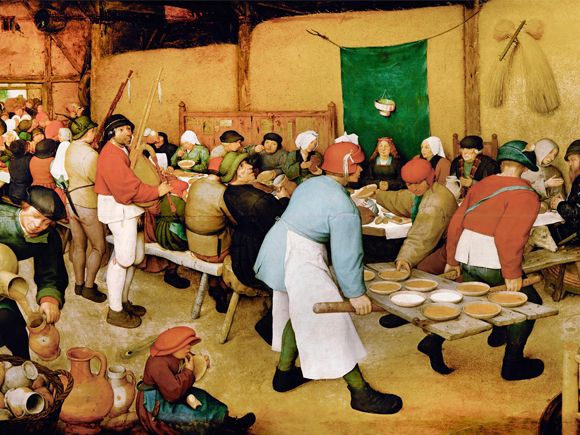“In 1345”, writes James Belich at the start of this ambitious, bold and engrossing book, “Europe and its neighbours were beset by a terrible plague.” Proportionally speaking, the Black Death was likely the most lethal catastrophe in human history, killing millions in Europe, Africa and Asia. Few were spared. Class, gender and diet provided no protection. Records from Norway, England and Greece suggest mortality rates as high as 60 per cent during the first wave.
The spread of the Black Death owed much to the creation of intercontinental trade networks over land and sea that joined three continents together. Although those routes had existed for millennia, the expansion of a vast Mongol empire in the 13th century meant that goods and people travelled further, faster and more cheaply than ever before—something that Belich, an Oxford professor of history, argues was not just a key factor for the disease to spread so quickly, but a prerequisite.
The Mongol conquests helped unlock the areas of central Asia that are home to the yersinia pestis bacteria—which was transmitted by fleas that hitched rides on rats and other animals, in sacks of grain and on clothes. It proved devastating. “The year 1348 left us lonely and bereft”, wrote the poet Francesco Petrarch. The “losses are beyond recovery, and death’s wound beyond cure. There is just one comfort: that we shall follow those who went before.”
What made things worse was that the Black Death did not come and then go, but recurred again and again and again. We should not think of one, but about 30 Black Deaths, says Belich; the disease lingered for centuries, scarring the Balkans until the 1770s, the Ottoman Empire for more than 50 years after that and with local outbreaks in Russia until the end of the 19th century.
Its impacts were not uniform, however, with some regions either spared or seeming to suffer less from the ravages of disease—Poland, for example, and many parts of Yuan dynasty China. (Although, as Belich notes, new evidence suggests there may have been more Chinese victims than previously thought.) Nonetheless, its broad effects ranged from massive demographic shifts to changing imperial fortunes: Belich argues that the Black Death was instrumental in the fall of two empires (those of Byzantium and the Mongol Golden Horde) and the rise of two others (the Ottomans and Timurids).
Much has been written about the devastation and suffering caused by plague, but Belich is more interested in its historical consequences. He starts by asking a different question: “Why Europe?” How did Europe manage to not only overtake other parts of the world, but to literally take them over? How did Europe manage to surge ahead in the arts and sciences and transform the world? His bold answer is that this all traces back to the Black Death.
“It seems almost inhumane”, writes the author, “to find a silver lining in a cloud as dark as the Black Death.” In fact, plague served to spark a series of innovations, changes and development; out of the gloom, writes Belich, came “a golden age” that lasted for more than 150 years. The reason for this was that, because so many people had died, there was a “plague bonus”: huge numbers of deaths meant that there was a dramatic rise in the “per capita availability of carts, wagons, horses, oxen, mules, boats, ships, barns and granaries.” This enabled “a fundamental reshuffling of the western European economy.”
In making his argument, Belich draws on a vast array of bang-up-to-date material with the latest historical research, from plague pathogens to the role of war in centralising the early modern and modern state. The ride is a provocative and often exhilarating one.
The fact that there were fewer mouths to feed sparked a spike in protein consumption, partly caused by the collapse in the price of cattle, but also because farmers had little choice but to expand their geographic and economic footprints by taking their herds to new -markets. This in turn created what Belich calls “an international meat trade in livestock”, which also helped establish trade connections that proved important for the exchanges of other goods and ideas.
Plague served as a catalyst to personal relationships: there was “nuptial frenzy” among those who had survived the first wave of the disease or had lost partners and sought to find replacements. Before the Black Death, Givry in Burgundy recorded just over a dozen marriages per year on average; after it, there were almost 100. It was a similar story in Durham, where the numbers of those getting married rose 10 times.
People changed how they worshipped, lived and behaved, says Belich. Competitive consumption patterns fuelled fine dining with consumers moving from capons, ducks and geese to swans, herons and peacocks. New elaborate clothing styles emerged, to the exasperation of some. In Venice in 1511, the Senate issued an order that “all new fashions are banned” to try to control expenditure and frippery.
There were long-term downsides too: the fall in available labour led to the revival of a substantial slave trade, not least within the Mediterranean where “perhaps 1.5 million Christians fell victim” to slave-trading between 1350 and 1800, to say nothing of the large numbers of Slavic peoples enslaved during the same period.
The shortage of manpower, says Belich, underpinned technological changes such as the shift from oar to sail in European shipping fleets. New ways were needed of doing old things. Book production collapsed after the Black Death, both because of the “deaths of authors and copyists” but also thanks to “increased wages for the survivors and the consequent rise in the costs of production.” The result was a western European “print revolution” spurred by incentives to create cheap books, which ultimately led towards Johannes Gutenberg and his collaborators developing printing with moveable metal type—according to Belich “a creature of plague.”
Using the Black Death as an anchor for developments and trends that sometimes lie decades or even centuries apart can be more convincing in some areas than others, as the author himself notes. When discussing the early modern period in Britain and the Industrial Revolution—a topic that turned up 824,000 books and articles when Belich searched databases of historical research—he comments here: “Locating the roots of eighteenth-century British globalisation and industrialisation in the plague era four centuries earlier may seem to draw a very long bow indeed,” which is something of an understatement.

Nevertheless, this study is to be greatly admired for its range and scope. Belich asks profound questions and does so with considerable elan. The centuries that followed the catastrophic plague pandemic were not just important for Europe but for many other non-European empires too. He charts the Ottoman expansion into the Indian Ocean and draws attention to Moroccan and Omani expansions and to the central role played in maritime trade of Gujaratis, Chinese, Javanese and Japanese—groups seldom mentioned in histories of the early modern period.
Belich is terrific, too, in picking out themes whose importance are too often underplayed or ignored. The Genoese, for example, are restored to their rightful starring role in the transformation of the states of Iberian Peninsula into global superpowers. This was thanks to the scientific knowledge, financial expertise and the willingness and ability of Genoa’s merchants, sailors and adventurers—of whom Christopher Columbus was just one—to expand economic, geographical and political horizons.
Belich is equally excellent on the “camouflaged empires” such as Lübeck whose connections into the Baltic and shipments of timber were vital for galvanising commerce. It was crucial, too, for the construction of navies that helped the meteoric rise of western Europe, which went from controlling 5 per cent of the planet’s surface in 1400 to 35 per cent by 1800, and 80 per cent by 1900.
The book is snappily written: the Ottomans were “the ultimate plague managers”, while European powers developed “expansion kits” centred on military and naval hardware (among other things) that offered decisive advantages in colonial occupation and control. The way talent was spotted in Constantinople was almost like “an Ottoman Rhodes Scholarship”, a nice turn of phrase that captures how merit was more important than birth in that society.
However, following Belich’s narrative does require some specialist knowledge—I am not sure everyone knows who the Byzantine Narses was, for example, or how commonplace the understanding of “Zomian margins” are. Specialist readers, though, who are interested in “internalist” or “externalist” readings of overseas expansion or that “Benjamin Kedar’s argument of 1976 is still accepted by some” regarding the decline of Genoese trading are in for a treat, for this is high-grade history written with flair, style and great attention to detail.
Nuggets abound, especially in the second half of the book which is less focused on the direct consequences of the Black Death and more on the 18th and 19th centuries. We learn, for example, that the US War of Independence essentially had no impact on trade between the newly created United States and Britain—volumes of trade actually rose after 1776. As London grew, it needed more food to feed the population. That produced changes in the amount of land being cultivated in Kent, Suffolk and Sussex and then to the way Ireland was developed and its people treated. Daughter cities such as Liverpool or Glasgow rose in conjunction, spurred on by cheaper labour: over the course of the 1700s, Liverpool’s population rose almost 20 times, creating new drivers of innovation, new technologies and efficiency.
“The Black Death not only halved populations”, says Belich in his stark conclusion, “but also doubled the average amount per person of everything.” As such, it produced a whole series of gains that were surprising and often positive. The Black Death “gave common folk among the survivors a taste of a materially better life” he writes, although the story was somewhat different for those on the other side of the equation, for Europe’s rise came at the expense of other continents.
Having just come through a new lethal pandemic ourselves—even if nothing like as bad as the plague of the 1340s—one needs a strong constitution to wish that more people had died. Let’s hope those in charge of global economies today don’t take that to heart and conclude that the best way to address inequality, stimulate growth and boost consumption patterns is to bump off large parts of the population. Even if, as Belich says, pandemics can have silver linings.













